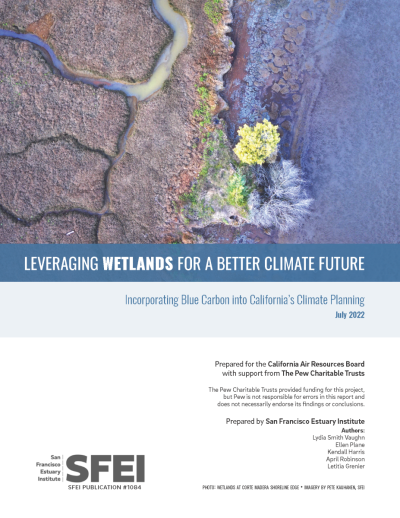Library
Our library features many hundreds of entries.
To search among them, click "Search" below to pull down options, including filtering by document type, author, year, and keyword.
Find these options under "Show only items where." Or you can also sort by author, title, type, and year clicking the headings below.
Export 13 results:
Filters: First Letter Of Last Name is V [Clear All Filters]
2023. Pharmaceuticals, pesticides, and ultraviolet filters in wastewater discharges to San Francisco Bay as drivers of ecotoxicity. Environmental Pollution 336 . SFEI Contribution No. 1153.
Research in the United States evaluating ecotoxic risk to receiving waters posed by contaminants occurring in wastewater discharges typically has focused on measurements of pharmaceuticals and personal care products (PPCPs), with limited evaluations of UV filters and phenylpyrazole and neonicotinoid pesticides. In this study, concentrations of 5 representative pharmaceuticals, 11 pesticides or pesticide degradation products, and 5 ultraviolet filters were measured in 24 h composite samples of six wastewater discharges representing ∼70% of the total wastewater discharged to San Francisco Bay during the summer and fall of 2021. No significant difference was observed between concentrations measured on weekdays vs. weekends. A hydrodynamic model of San Francisco Bay was used to estimate annual average dilution factors associated with different subembayments. With and without considering dilution effects, Risk Quotients were calculated using the 90th percentile of measured concentrations in wastewater effluents and threshold concentrations associated with ecotoxicity. Risk Quotients were highest for the neonicotinoid pesticide, imidacloprid, and exceeded ecotoxicity thresholds in the lower South Bay by a factor of 2.4, even when considering dilution. Compared to commonly measured pharmaceuticals, Risk Quotients for imidacloprid were higher than those for carbamazepine, trimethoprim and diclofenac, and comparable to those for propranolol and metoprolol. Risk Quotients for the pesticide, fipronil, and the UV filter, oxybenzone, were higher than for carbamazepine. The results highlight the need to incorporate pesticides and UV filters with high Risk Quotients into studies in the United States evaluating ecotoxic risk associated with contaminants in municipal wastewater discharges.
. 2014. What is Flood Control 2.0 (Podcast).
2023. Managing Open Space in Support of Net Zero: Carbon sequestration opportunities and tradeoffs in the Alameda Watershed. San Francisco Estuary Institute: Richmond, CA. p 120.
2022. Delta Wetland Futures: Blue Carbon and Elevation Change. SFEI Contribution No. 1105. San Francisco Estuary Institute: Richmond, CA.
2022. Leveraging Wetlands for a Better Climate Future: Incorporating Blue Carbon into California's Climate Planning. SFEI Contribution No. 1084. San Francisco Estuary Institute: Richmond, CA. p 31.
 The 2022 update to California’s climate change Scoping Plan incorporates management actions in the state’s forests, shrublands/chaparral, grasslands, croplands, developed lands, deltaic wetlands, and sparsely vegetated lands. Missing from this list are the tidally-influenced coastal ecosystems outside the Sacramento-San Joaquin Delta. These blue carbon ecosystems support high rates of carbon storage and sequestration while providing many co-benefits that can enhance coastal climate change resilience. With sufficient data and robust modeling approaches, California has the opportunity to incorporate blue carbon in future Scoping Plan updates and set actionable targets for restoration, migration space conservation, and other management activities that promote long-term survival of the state’s coastal wetlands. To support this goal, this report offers a high-level overview of the state of the science for blue carbon quantification in California. This summary, which covers datasets and quantification approaches, key focus areas for additional science investment, and example scenarios for coastal wetland restoration, is intended to facilitate broader inclusion of blue carbon in future Scoping Plan updates and other state-level climate-planning documents.
The 2022 update to California’s climate change Scoping Plan incorporates management actions in the state’s forests, shrublands/chaparral, grasslands, croplands, developed lands, deltaic wetlands, and sparsely vegetated lands. Missing from this list are the tidally-influenced coastal ecosystems outside the Sacramento-San Joaquin Delta. These blue carbon ecosystems support high rates of carbon storage and sequestration while providing many co-benefits that can enhance coastal climate change resilience. With sufficient data and robust modeling approaches, California has the opportunity to incorporate blue carbon in future Scoping Plan updates and set actionable targets for restoration, migration space conservation, and other management activities that promote long-term survival of the state’s coastal wetlands. To support this goal, this report offers a high-level overview of the state of the science for blue carbon quantification in California. This summary, which covers datasets and quantification approaches, key focus areas for additional science investment, and example scenarios for coastal wetland restoration, is intended to facilitate broader inclusion of blue carbon in future Scoping Plan updates and other state-level climate-planning documents.
2023. Adding Salinity Modifiers to CARI - Methods Brief. San Francisco Estuary Institute.
2024. Managed wetlands for climate action: potential greenhouse gas and subsidence mitigation in the Sacramento-San Joaquin Delta. In Press.
2020. Livestock grazing and its effects on ecosystem structure, processes, and conservation. SFEI Contribution No. 1011. San Francisco Estuary Institute: Richmond, CA.
2020. Delta Landscapes Primary Production: Past, Present, Future. SFEI Contribution No. 988. San Francisco Estuary Institute: Richmond, CA.
This report describes the Delta Landscapes Primary Production project, which quantifies how landscape change in the Delta has altered the quantity and character of primary production. Combining historical and modern maps with simple models of production for five dominant plant and algae groups, we estimate primary production across the hydrologically connected Delta. We evaluate changes in primary production over time (between the early 1800s and early 2000s), between wet and dry years, and with future targets for landscape-scale restoration. For managers in the Delta, restoring historical patterns of primary productivity is a means to better support native fish and other wildlife. To better equip decision makers in managing for improved primary production, this study offers historical context and the best available science on the relative production value of habitat types and their configurations.
2002. Tidal Marsh Vegetation.
2002. Data Collection Protocol Tidal Wetland Vegetation. SFEI Contribution No. 279. San Francisco State: San Francisco, CA. p 13.

